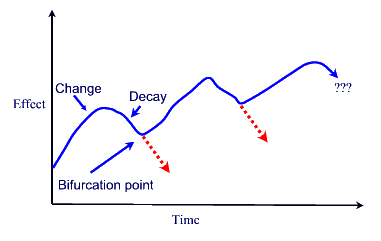
Change is a little like a plant. It grows when the conditions are right. Change happens when two conditions occur, when:-
Conversely, decay (or back-sliding) begins when:-

Figure 1: Change & Decay
The model above is a much simplified depiction of the Nobel Prize-winning physicist, Ilya Prigogine’s, work. He observed that although the second law of thermodynamics suggests that all systems are running down to a state of entropy or decay, this did not appear to be true of what he termed ‘open’ systems. These are systems that are living and exchange energy with their environment, examples of these are people and companies. These ‘open’ systems draw energy from their surroundings and deposit their waste. An obvious example of this is industrial pollution.
One significant element of his theory that is relevant to us in business is what he terms the Bifurcation Point [BP]. This where a system has reached a point of breakdown where it can take two different paths. Either it continues to degenerate, or reorganises itself into a new structure that can cope with the stresses that were previously causing it to fail. We have all probably lived through phases of company (and personal) history where things suddenly turned a corner and we recognised that there were new possibilities emerging (and also the converse, where the decay continued & got worse).
At the BP people either develop new neural connections within the brain, new insights, new ways of thinking and behaving or continue their downward vector.
In companies it is just the same pattern. The BP is where real breakthrough thinking happens, new ideas, new ways-of-working. This is where management commit to change; where new people (the natural leaders within the group) emerge. This is the point where people will no longer accept “We’ve always done it this way”.
All systems are in a constant state of change, whether we direct them or not. Holding a steady state takes a great deal of energy and is no long term strategy as it is doomed to failure. Growth or Decay are our only real choices, which do you choose? Both are painful; both consume resources and efforts, but the results are very different.
Here are some questions to ask yourself:-
The BP is where need meets willingness. If you aren’t on the way up from it, then you are probably heading down to meet it, so be ready!
For people interested in change this is important because if our change programme is running out of steam, we need to either remove some of the negative conditions listed above or inject the positive ones.
Change is not only inherently risky, but we are hardwired to fear it. If we are saying that we think that things should change, then it means that they are not alright now! That implies criticism and possibly blame. We all have a strong need to believe not only that we are okay, but we are also safe. We constantly seek to create a stable situation that is ‘okay’ and maintain it at all costs. However commercial life (and evolution) does not stand still and they do not allow us to, if we wish to succeed!
Any change program that does not recognise that change is more than just a project gant chart is doomed to failure. We have to create an environment in which the chances for change flourishing are significantly increased; in the same way we would propagate tender young seedlings. Ensuring that they had the right growing medium and where shielded from the rough elements before they were ready.
Do you know who your promising young (whatever their chronological age!) ‘seedlings’ are? What are you doing to look after them? They are critical to your business. One example of Prigogine’s theories is the experience of the theatre audience. A few people start clapping and suddenly everyone is. This action of a few, changes the experience for everyone both in the audience and on the stage.
You don’t have to be Einstein to run a business but it certainly seems that a basic understanding of the laws of thermodynamics can help!
Testimonials:
Richard has a depth of experience and a wealth of anecdotes which always helped me to see things differently and more clearly - Business Solutions Group Manager National Grid Wireless
click here for more testimonials

What's New?
Article: Management and Change Management
Blog: We've been Trumped... or Brexit pt II
In describing today's accelerating changes, the media fire blips of unrelated information at us. Experts bury us under mountains of narrowly specialized monographs. Popular forecasters present lists of unrelated trends, without any model to show us their interconnections or the forces likely to reverse them. As a result, change itself comes to be seen as anarchic, even lunatic. - Alvin Toffler